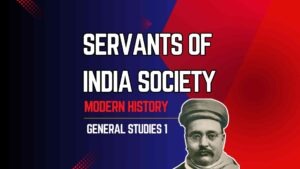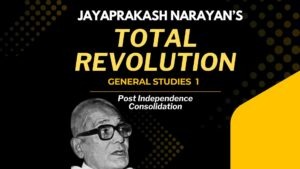Jayaprakash Narayan - Total Revolution
Jayaprakash Narayan - Total Revolution
Introduction
- In News: Commemorating the 51st anniversary of Jayaprakash Narayan’s (JP) “Total Revolution” call on June 5, 1974, at Gandhi Maidan, Patna.
- Concept: A holistic, non-violent movement for socio-political transformation rooted in Gandhian principles, aiming for “Sampoorna Kranti” (comprehensive change) across economic, political, social, and cultural domains.
- Launched by: Jayaprakash Narayan (JP), a prominent freedom fighter and Sarvodaya leader.
- Objective: To establish a just, equitable, and participatory society by addressing systemic issues in governance, economy, and society.
Historical Background
- Political Climate:
- 1970s India faced political instability due to centralized power, erosion of democratic norms, and suppression of dissent.
- The 1975 Allahabad High Court verdict invalidating Indira Gandhi’s election due to electoral malpractices sparked widespread protests.
- Economic Crisis:
- High inflation (>20%), unemployment, and food shortages in the early 1970s fueled public discontent.
- Economic mismanagement deepened poverty and inequality.
- Social Unrest:
- Student-led movements like Gujarat’s Navnirman Andolan and Bihar’s student protests highlighted youth frustration over unemployment and governance failures.
- Widespread disillusionment with the state’s inability to address socio-economic challenges.
- JP’s Leadership:
- JP combined Gandhian ethics, Sarvodaya ideals, and Marxist critiques to propose a “party-less democracy.”
- His call for Total Revolution galvanized a broad-based, non-violent mass movement.
Causes of Total Revolution
- Electoral Malpractices: The Allahabad HC verdict (1975) against Indira Gandhi delegitimized her leadership, intensifying public distrust.
- Economic Distress: Severe inflation, unemployment, and food scarcity exposed systemic economic failures.
- Student Agitations: Navnirman Movement (Gujarat) and Bihar student protests reflected youth unrest and demands for systemic change.
- Democratic Erosion: Centralization of power, misuse of laws like MISA (Maintenance of Internal Security Act), and suppression of dissent threatened democratic values.
- Inspirational Leadership: JP’s vision of ethical governance and grassroots democracy resonated with diverse groups, including students, intellectuals, and civil society.
Components of Total Revolution
- Political Revolution:
- Advocated participatory, bottom-up governance to counter bureaucratic centralism.
- Emphasized accountability, transparency, and decentralization of power.
- Economic Revolution:
- Focused on equitable land redistribution and people-centric development models.
- Aimed to reduce socio-economic disparities and promote inclusive growth.
- Social Revolution:
- Targeted eradication of casteism, gender discrimination, and dowry.
- Promoted social equality and inclusivity.
- Educational Revolution:
- Proposed an ethics-based curriculum emphasizing civic duties, rural development, and vocational training.
- Aimed to empower youth for nation-building.
- Cultural-Spiritual Revolution:
- Encouraged self-discipline, moral rejuvenation, and national unity.
- Focused on individual transformation as the foundation for societal change.
Impact of Total Revolution
On People
- Youth Mobilization: Catalyzed the rise of new political leaders like Lalu Prasad, Nitish Kumar, and Sushil Modi, reshaping Bihar’s political landscape.
- Civic Consciousness: Enhanced public engagement in democratic processes and accountability.
- Non-Violent Resistance: Reinforced the efficacy of peaceful protests, influencing later movements like Anna Hazare’s anti-corruption campaign (2011).
On Governance
- Rise of Non-Congress Coalition: Unified opposition during the Emergency (1975-77), leading to the Janata Party’s victory in 1977.
- Constitutional Reforms: Prompted the 44th Amendment (1978), which limited Emergency powers and restored judicial oversight.
- Decentralization: Laid the groundwork for Panchayati Raj reforms (73rd and 74th Amendments, 1992), strengthening grassroots democracy.
Significance of Total Revolution
- Revival of Dissent: Legitimized dissent as a democratic right, reinforcing India’s tradition of protest.
- Leadership Development: Produced a new generation of mass-based leaders who shaped Indian politics.
- Institutional Reforms: Exposed systemic vulnerabilities, leading to stronger democratic safeguards.
- Civil Society Expansion: Broadened the public sphere, encouraging civil society participation in governance.
- Contemporary Relevance: Offers lessons for addressing modern challenges like centralization, youth alienation, and democratic backsliding.
Additional UPSC-Relevant Insights
- Link to Indian Freedom Struggle: Total Revolution drew inspiration from Gandhian principles of non-violence and self-reliance, echoing the Swadeshi and Satyagraha movements.
- Emergency Context: The movement gained momentum during the Emergency (1975-77), highlighting resistance to authoritarianism.
- Influence on Modern Movements: Its legacy is evident in movements like the Right to Information (RTI) campaign and anti-corruption drives, emphasizing transparency and accountability.
- Relevance to UPSC Syllabus:
- GS Paper 1: Post-independence consolidation, social empowerment.
- GS Paper 2: Governance, role of civil society, constitutional amendments.
- GS Paper 4: Ethics in governance, leadership, and public service.
- Critiques:
- Utopian Nature: Critics argue the vision of “party-less democracy” was impractical.
- Fragmentation: The movement’s broad scope led to ideological divisions among supporters.
- Limited Long-Term Impact: While it influenced short-term political changes, systemic issues like corruption and inequality persisted.
Conclusion
Jayaprakash Narayan’s Total Revolution was a visionary call for ethical, democratic, and social transformation. Though its ambitious goals were only partially realized, it reshaped India’s political landscape, empowered civil society, and inspired future reforms. Its emphasis on non-violence, decentralization, and public participation remains relevant for addressing contemporary governance challenges.
Mains-Based Questions on Jayaprakash Narayan - Total Revolution
Q1. “Total Revolution was not just a protest against the Emergency, but a blueprint for democratic renewal.” Examine.
(GS Paper 2 – Polity & Governance)
✅ Answer Framework:
Introduction:
Define Total Revolution (Sampoorna Kranti) as conceptualized by Jayaprakash Narayan in 1974.
Highlight that while it gained momentum during the Emergency, its goals were deeper and long-term.
Body:
🔹 A. Beyond Emergency – Vision of Systemic Change:
JP’s call was for moral, ethical and institutional transformation.
Called for a “Party-less democracy”, Gandhian decentralisation, and mass civic engagement.
🔹 B. Multi-dimensional Nature of the Movement:
Political – Participatory governance and accountability.
Economic – Equity-based development.
Social – Eradication of casteism, dowry, and gender bias.
Educational & Cultural – Value-based education and moral rejuvenation.
🔹 C. Institutional Reforms Triggered:
44th Amendment post-Emergency: curbing arbitrary Emergency powers.
Encouraged 73rd & 74th Amendments for Panchayati Raj.
Inspired future civil society-led movements (e.g., anti-corruption movement of 2011).
🔹 D. Shift in Political Landscape:
Rise of non-Congress coalitions (e.g., Janata Party in 1977).
Emergence of new regional leaders (e.g., Lalu Prasad, Nitish Kumar).
Conclusion:
Total Revolution aimed at redefining governance as a public-spirited and ethical activity.
Its significance lies in its continued relevance in tackling centralisation, corruption, and erosion of democratic values.
🔶 Question 2
Q2. Critically analyse the concept of ‘Party-less Democracy’ as proposed by Jayaprakash Narayan in the context of the Total Revolution.
(GS Paper 2 – Polity)
✅ Answer Framework:
Introduction:
Introduce the idea of ‘Party-less Democracy’ as a core element of JP’s Total Revolution.
Emphasize that it emerged from disillusionment with political parties and their degeneration.
Body:
🔹 A. Rationale Behind the Concept:
Political parties seen as vehicles of corruption, authoritarianism, and power politics.
JP envisioned direct democracy, rooted in Gandhian principles of decentralisation and Sarvodaya.
🔹 B. Features of Party-less Democracy:
Governance through local self-governments (Panchayats).
Issue-based citizen participation rather than allegiance to party ideologies.
Emphasis on ethical and civic leadership over electoral manipulation.
🔹 C. Criticism & Limitations:
Idealistic and impractical in a large, pluralistic democracy.
Political parties essential for aggregation of interests, policy formulation, and accountability.
Absence of parties may lead to chaotic governance or rise of informal power groups.
🔹 D. Contemporary Relevance:
Reflects concerns about criminalisation of politics, dynastic rule, and ideological vacuum.
Can inspire electoral reforms, inner-party democracy, and greater citizen engagement.
Conclusion:
While utopian in vision, the concept of party-less democracy challenges us to rethink the purpose and quality of our political institutions.
Its spirit can guide reforms within the party system rather than replacing it.
🔶 Question 3
Q3. Discuss the relevance of the Total Revolution movement in contemporary India.
(GS Paper 2 – Governance)
✅ Answer Framework:
Introduction:
Introduce the Total Revolution as a historic movement launched in 1974 by JP against moral and institutional decay.
Briefly mention its enduring influence.
Body:
🔹 A. Present-day Challenges Similar to the 1970s:
Centralisation of power, erosion of democratic institutions.
Youth alienation and rising unemployment.
Corruption, electoral malpractices, weakening accountability.
Inequality, caste discrimination, gender bias.
🔹 B. Relevance of JP’s Vision Today:
Participatory democracy and decentralisation (Panchayati Raj).
Ethics in politics – Clean leadership and moral responsibility.
Citizen movements – RTI, anti-corruption, environmental activism.
Youth mobilisation for democratic accountability (e.g., student-led protests).
🔹 C. Lessons from the Movement:
Dissent is a democratic strength, not a threat.
Need for multi-dimensional reform – not just economic or political.
Civil society must act as watchdog and catalyst for change.
Conclusion:
Total Revolution is not merely a historical event, but a moral framework for rebuilding democracy.
Its relevance is profound in an era where institutions are tested, and public trust in governance is declining.
🔶 Question 4
Q4. Evaluate the impact of the Total Revolution on India’s democratic and constitutional development.
(GS Paper 1 – Post-Independence History / GS2 – Polity)
✅ Answer Framework:
Introduction:
Briefly state that Total Revolution was a watershed in Indian democracy, responding to an acute political and constitutional crisis.
Body:
🔹 A. Strengthening of Democratic Institutions:
44th Constitutional Amendment: Curbed Emergency powers.
Restoration of Judicial Review, Fundamental Rights, and civil liberties.
🔹 B. Electoral & Political Reforms:
Rise of Coalition Politics.
Shift from Congress dominance to multi-party democracy.
🔹 C. Grassroots Governance:
Influence on 73rd and 74th Amendments.
Push for bottom-up participation in governance.
🔹 D. Public Awareness & Civic Participation:
Empowered citizens to question authority.
Normalised non-violent protests as a democratic tool.
Conclusion:
JP’s movement catalysed constitutional introspection and democratic resilience.
It laid the foundation for India’s transformation into a participative, vigilant, and plural democracy.
Prelims Questions based on Jayaprakash Narayan - Total Revolution
-
Important Mountain Ranges in India
When preparing for UPSC, mapping is crucial. The exam often... -
Important Indian Maps – Political Boundaries
Important Indian Maps - Political Boundaries of India comprises of... -
Servants of India Society – Important UPSC Notes
Servants of India Society was founded by Gopal Krishna Gokhale.... -
Sea Level Rise at India’s Coastal Region – Important UPSC Notes
The World Meteorological Organization (WMO) released its State of the... -
Indian Urban Drainage Crisis – Important UPSC Notes
The post "Indian Urban Drainage Crisis" talks about the issue... -
Jayaprakash Narayan Important UPSC Notes
Commemorating the 51st anniversary of Jayaprakash Narayan’s (JP) “Total Revolution”... -
Sant Kabir Das – UPSC Notes
Sant Kabir Das Jayanti was celebrated on June 11, 2025,...








